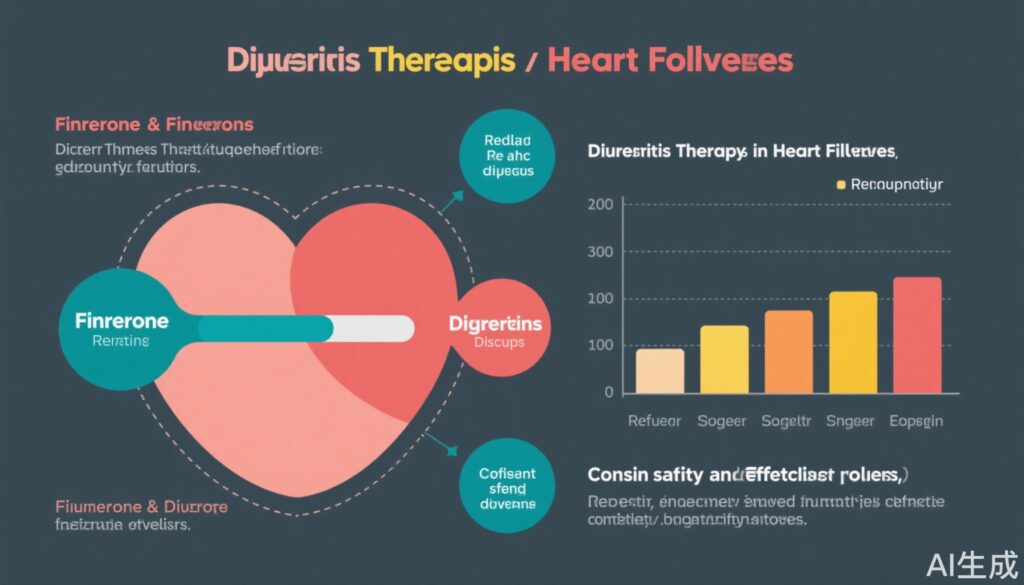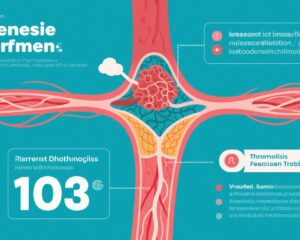Highlights
- Finerenone shows consistent efficacy and safety in heart failure patients irrespective of baseline diuretic regimen.
- Use of finerenone leads to reduced intensification and dosage of loop diuretics in heart failure with mildly reduced or preserved ejection fraction (HFmrEF/HFpEF).
- Although finerenone does not reduce initiation of new loop diuretics, it facilitates diuretic-sparing by decreasing dose escalation and promotes dose reductions/discontinuation.
- Safety profile remains stable across diuretic categories, supporting finerenone’s suitability in combination regimens.
Background
Heart failure (HF) with mildly reduced or preserved ejection fraction (HFmrEF/HFpEF) represents a significant clinical challenge, characterized by fluid overload and frequent use of diuretics for symptomatic management. Loop and nonloop diuretics remain foundational for volume control but carry risks including electrolyte imbalances and renal dysfunction. Mineralocorticoid receptor antagonists (MRAs), such as finerenone, have emerged as therapeutic agents with cardiovascular and renal protective effects. A critical question is whether finerenone can reduce dependence on diuretics (a diuretic-sparing effect), potentially minimizing diuretic-related adverse effects and improving patient outcomes.
Key Content
Methodology: The FINEARTS-HF Trial and Secondary Analysis
The Finerenone Trial to Investigate Efficacy and Safety Superior to Placebo in Patients With Heart Failure (FINEARTS-HF) was a multinational, randomized, placebo-controlled clinical trial with 6001 patients with symptomatic HFmrEF/HFpEF (LVEF ≥40%) enrolled across 653 sites in 37 countries. Participants had experienced New York Heart Association (NYHA) class II-IV symptoms and exhibited elevated natriuretic peptides.
A prespecified secondary analysis evaluated 5438 patients with baseline diuretic use. Background diuretic therapy was categorized as:
- Only nonloop diuretics (e.g., thiazides)
- Loop diuretics at ≤40 mg/day furosemide-equivalent dose
- Loop diuretics at >40 mg/day
- Combination of loop and nonloop diuretics
Patients were randomized to finerenone (titrated to 20 or 40 mg daily) or placebo. The primary outcome was a composite of total heart failure events (first and recurrent) and cardiovascular death.
Results on Efficacy and Diuretic-Sparing Effects
At baseline, 12.6% used nonloop diuretics exclusively, 55.9% used ≤40 mg of loop diuretics, 21.1% used >40 mg loop diuretics, and 10.5% received combination therapy.
Finerenone consistently reduced risk of the primary composite outcome across all diuretic groups with rate ratios ranging from 0.54 to 0.98, showing no significant interaction by diuretic category (P=0.18). Notably, patients receiving finerenone were less likely to undergo increases in diuretic dose at 6, 12, and 18 months (P<.01 for all) and more likely to have dose reductions or discontinuations (P<.001 for all), signifying a diuretic-sparing effect. However, finerenone did not influence the initiation of new loop diuretics in patients who were not on loop diuretics at baseline.
Safety Profile
The tolerability of finerenone was consistent across all diuretic subgroups. Rates of hyperkalemia and renal adverse events were manageable with protocol-directed monitoring and dose adjustment, supporting finerenone’s safety when combined with diuretics.
Supporting Evidence from Related Outcomes in FINEARTS-HF
Additional secondary analyses corroborate finerenone’s benefits, including reductions in outpatient diuretic intensifications, improvements in patient-reported health status (Kansas City Cardiomyopathy Questionnaire scores), and cardiovascular event reductions independent of loop diuretic dose or background sodium-glucose cotransporter-2 inhibitor use.
Expert Commentary
Finerenone’s distinct nonsteroidal mechanism as a mineralocorticoid receptor antagonist confers cardiovascular and renal protection with fewer hormonal side effects compared to steroidal MRAs. The demonstrated ability to reduce escalation and facilitate downtitration of loop diuretics is clinically meaningful; high-dose diuretics are associated with adverse outcomes including neurohormonal activation and worsening renal function. By alleviating the need for higher diuretic doses, finerenone may mitigate associated risks.
However, the lack of effect on loop diuretic initiation suggests that finerenone’s diuretic-sparing impact is more pronounced in modifying ongoing diuretic therapy rather than preventing the introduction of loop diuretics. This distinction highlights the necessity of early and integrated management approaches.
Guideline recommendations increasingly recognize MRAs’ role in HFmrEF/HFpEF, with finerenone’s evidence base supporting its use alongside diuretics. Safety monitoring for hyperkalemia remains essential, but trial data suggest finerenone’s risk is manageable.
Conclusion
The prespecified analysis of the FINEARTS-HF trial provides robust evidence that finerenone offers consistent cardiovascular benefit across patients with HFmrEF/HFpEF regardless of baseline diuretic therapy. Importantly, finerenone exhibits a diuretic-sparing effect by reducing the need for loop diuretic dose intensification and enabling dose reductions, potentially diminishing diuretic-associated complications.
While finerenone does not reduce the initiation of loop diuretics, its role in optimizing diuretic regimens makes it a valuable therapeutic option in HF management. Further research may elucidate long-term clinical outcomes associated with diuretic dose reductions facilitated by finerenone.
References
- Chimura M, Jhund PS, Henderson AD, et al. Efficacy and Tolerability of Finerenone According to the Use and Dosage of Diuretics: A Prespecified Analysis of the FINEARTS-HF Randomized Clinical Trial. JAMA Cardiol. 2025 Aug 13;doi:10.1001/jamacardio.2025.2551. PMID: 40802267; PMCID: PMC12351465.
- Jhund PS, Desai AS, Claggett BL, et al. Finerenone and Outpatient Worsening Heart Failure With Mildly Reduced or Preserved Ejection Fraction: A Secondary Analysis of the FINEARTS-HF Randomized Clinical Trial. JAMA Cardiol. 2025 Feb 26;10(4):370-378. PMID: 40009358.
- Lam CSP, Voors AA, Zannad F, et al. Efficacy and Safety of Finerenone Across the Ejection Fraction Spectrum in Heart Failure With Mildly Reduced or Preserved Ejection Fraction: A Prespecified Analysis of the FINEARTS-HF Trial. Circulation. 2025 Jan 7;151(1):45-58. PMID: 39342512.
- Vaduganathan M, Claggett BL, Jhund PS, et al. Finerenone in Heart Failure With Improved Ejection Fraction: The FINEARTS-HF Randomized Clinical Trial. JAMA Cardiol. 2025 Jul 1;10(7):740-745. PMID: 40397470.
- Bär F, Petrie MC, Jhund PS, et al. Mineralocorticoid receptor antagonists and atrial fibrillation: a meta-analysis of clinical trials. Eur Heart J. 2024 Mar 7;45(10):756-774. PMID: 38195054.



